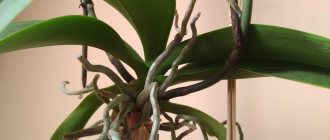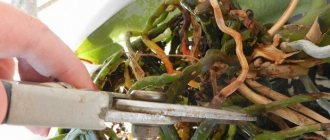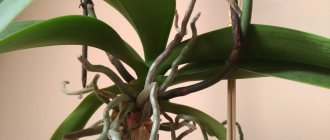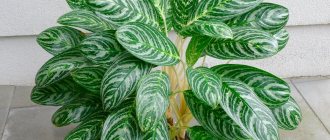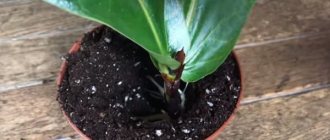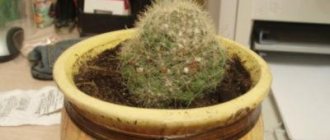How to recognize aerial roots
Before deciding what to do with the proverbial roots, they need to be recognized. An inexperienced gardener may decide that these are not roots, but new stems. Aerial roots form on the stems as the plant grows. As a rule, they grow opposite the leaves and have a slightly thickened, woody structure. Such shoots are colored not green, like the main stem, but light brown. Often such roots grow to an impressive length, “spreading” onto the floor near the pot.
What are they needed for
Aerial roots for indoor monstera are an additional tool for obtaining moisture: under natural conditions, this tropical plant grows in a climate zone where heavy warm rains often occur, and therefore the air is extremely saturated with moisture. Thanks to aerial roots, the vine can receive additional moisture not only from the soil, but also directly from the surrounding air, which is of great importance for the normal development and full life of the plant.
There is a direct relationship here: the more aerial roots a vine has, the more powerful, beautiful and healthy it will be. And under particularly favorable conditions, it can even please you with flowering. So aerial roots are certainly a necessary organ for a tropical beauty.
What to do with the roots
We figured out that the aerial roots of Monstera are far from being a useless organ. And yet, when grown at home, they pretty much spoil the overall picture, hanging with ugly brown shoots all the way to the floor, giving the plant an unkempt and unkempt appearance. To correct the situation, there are several ways to deal with annoying roots:
- you can carefully tie the roots to the main stems as they form, so that they gradually reach the ground and can take root on their own;
- or place a couple of more pots with soil near the container with the monstera, and direct the root shoots into them. Then after rooting you will get several more young vines;
- You can place bottles of water so that rooting occurs not in the soil, but in the water. In this case, it is important not to forget to change the water to fresh water on time;
- some wrap the roots in damp moss. This option adds aesthetics and allows the rooting process to begin;
- Gardening stores often sell special plastic supports decorated with dried palm fiber. An overgrown vine can be fixed on such a support by making small holes in it to secure the aerial shoots. Sometimes such holes are filled with earth or simply sprayed regularly from a spray bottle;
- The aerial root shoots of the vine can simply be trimmed. True, not all, and not completely. The plant will not be harmed if you remove a small part of all the aerial roots, or shorten them slightly to give the composition a more attractive appearance. Of course, you should not remove absolutely all the shoots - in this case, the monstera may get sick or even die. The least problem you will encounter in this case is yellowing of the leaves and decreased vitality of the plant.
So there are many safe and effective ways to transform your tropical beauty. The main thing is not to get rid of the shoots as soon as they appear. If nature provides such an organ, then the plant needs it.
Just watch the growth of the roots and direct them where you need them in time. This way you will protect your monstera from diseases and give your favorite flowerpot a truly elegant and blooming look.
Video “Transplanting indoor monstera”
From this video you will learn how to properly transplant an indoor monstera.
According to experts, the described monstera roots help obtain additional moisture. The tropical monstera vine grows naturally in the hot tropics, where there is often heavy rain and the air is oversaturated with life-giving moisture.
Thanks to its well-developed aerial roots, the plant can receive moisture not only from moist soil, but also from the air. The moisture obtained in this way has a beneficial effect on the development of the exotic plant.
Experts say that there is a direct relationship: the longer and denser such roots are, the healthier and stronger the monstera will grow.
When creating favorable conditions for the development of a flower, sometimes an obstinate beauty can please with its unusual flowering. The correct development of the vine will become absolutely impossible if it is deprived of this device.
An interesting opinion is that such roots are important not only for the growing plant, but also for its owner. Based on the condition of the roots, an experienced gardener will always be able to determine the condition of the vine in one or another phase of its development.
Taking into account the above arguments, we can come to the conclusion that these roots are vital organs of the plant.
Caring for the plant after transplantation
The plant easily gets along with other vines, so after transplanting it can be placed next to flowers such as scindapsus and philodendron. It is even possible to place such plants in one large pot.
Note! However, when choosing companions, it is necessary to take into account that the rules for caring for them should be the same.
The basic rules for subsequent plant care for its normal growth and development are presented in the table.
| Rule | Description |
| Choosing a place to plant | The liana cannot be placed in the aisle. She does not like drafts, because of which the leaves can turn yellow and acquire a brown tint. Direct sunlight also has a negative effect on the plant. Therefore, it is better to place the pot in a dark place. |
| Temperature | The indicator should vary between 16-22 °C. It can withstand low temperatures for a short period of time, but its growth slows down. At higher temperatures, severe leaf growth is possible. |
| Watering | In spring and summer, watering should be frequent and plentiful. The water required is soft and settled. Each subsequent watering is carried out only when the top part of the soil has dried. In autumn, the frequency of watering is reduced, and in winter, watering is done 2 days after the top of the soil in the pot has dried. |
| Humidity | Liana loves high air humidity. Therefore, spraying the leaves from the sprayer must be carried out constantly. When dust forms on the leaves, it must be removed with a wet soft cloth. Air humidification is reduced in winter. |
| Top dressing | The vines are fertilized in spring and summer. For this purpose, various organic and mineral fertilizers are used. It is possible to use specialized indoor fertilizers created specifically for plants of the Araceae family. Feeding is carried out 2 times a month, which is quite enough for growth. Young, recently transplanted plants do not require feeding. |
| Trimming | Pruning is not done too often. It is necessary to form the crown of the plant. If the flower stretches strongly upward, trim the top part so that the side shoots begin to grow. However, when pruning, you cannot remove the aerial roots of the plant. Old wilted leaves must be cut out. It is prohibited to pick leaves; they must be carefully cut off. |
Frequently encountered problems when caring for monstera after transplantation:
- dripping liquid from the leaves indicates that the vine is watered too much. Advice: reduce the amount and volume of water used;
- yellowness of the leaves indicates a lack of water for irrigation. Advice: water more often;
- paleness of the leaves indicates insufficient lighting of the vine. Tip: rearrange the colors to increase the amount of incoming light;
- the fact that slits do not form on the leaves indicates a lack of nutrients. Advice: feed using any available drug and method;
- a brown tint on the leaves indicates that the vine has become cramped in the pot. Advice: urgent transplant.
What is recommended to do with aerial roots?
Aerial roots bring many benefits to the plant; they enrich it with valuable moisture, which is necessary for the harmonious development of the vine.
But when growing a flower at home, these shoots can ruin the appearance of the monstera.
Over time, they become very long, and hanging untidy from the flower hill, they create an unkempt appearance.
Carefully tying them to the stems during the formation of the plant helps to reach soil shoots in which they can take root.
Near the flower pot in which the monstera is placed, you can place several small containers filled with soil. Such roots can be directed into these containers, and over time they will take root in them. After rooting, the gardener will have several young exotic plants.
Next to the monstera flower pot you can place several containers filled with settled water. This will promote rooting in water. When using this method, a novice gardener must remember that for good development it is necessary to change the water every three days.
Some experienced gardeners recommend wrapping the shoots with moss soaked in water. This method will add aesthetics to the appearance of the plant and speed up the process of natural rooting.
In special flower shops you can purchase plastic supports made to decorate the appearance of vines. Monstera is easily fixed in such a support; the air shoots (as in the picture below) are brought inside the support through small holes.
Monstera with aerial roots
When choosing this method, it is more important not to forget to spray the holes through which the aerial roots pass with a spray bottle.
The above methods do not involve cutting off the aerial shoots of a tropical vine.
But sometimes gardeners improve their appearance by partially cutting off untidy shoots that are growing and sticking out in different directions.
When using this method, it is important to remember that it is absolutely impossible to cut off absolutely all shoots. In this case, the plant will not be able to continue its development and will soon die.
Monstera will not suffer much if several of these roots are partially shortened. But such an operation can contribute to the appearance of yellow spots along the edges of the carved leaves of the vine.
The desire to grow a beautiful tropical plant in your home is quite real. Monstera will be a worthy decoration of any interior. When growing it, you should be careful with the shoots from its stems, which are vital for the plant.
While watching the video you will learn about caring for the monstera.
Monstera - in the photo
Seedling care
When propagating monstera by any chosen method, you need to remember to care for the flower after planting. The liana is not capricious, but it grows slowly and requires good light and warmth. Here are some tips for growing scions, cuttings or sprouts of this beautiful exotic plant.
- Choice of location and lighting. It is better to place the pot on western and eastern windows in a warm, fairly bright room. Liana does not like darkness; from a lack of light, its leaves become smaller and “holes” disappear on them. The light should be diffused, not too bright, so that sunburn spots do not appear on the leaves.
- Temperature. The plant loves warmth; the optimal room temperature for growing is 20-25°C in summer and up to 20° in winter, but not lower than +12-13°. With this content, the monstera will grow quickly, forming a thick green mass and fatty aerial roots.
- Air humidity. Liana loves regular moisture and responds well to weekly spraying of the leaves and wiping them with lukewarm water. Young plants can be washed in the shower or taken out in the rain in the summer to get rid of dust on the leaves.
- Watering. A tropical flower should be watered abundantly, especially in spring and summer, when it is hot outside and at home. The dugout lump should ideally never dry out. In winter, watering is slightly reduced and the intervals between soil moistening are increased. It is also impossible to flood the soil, this can lead to the death of the vine.
- Feeding. Monstera grows well without fertilizing, but to give the flower a beautiful look and the leaves a healthy shine, you can add any complex mineral compositions to the soil every 3 weeks from spring to late summer when watering.
- Support. In order for a climbing vine to grow upward and not fall or break, it requires the installation of a strong support. Usually they use purchased hollow plastic sticks wrapped in coconut fiber, less often they use plastic or wooden gratings, tie the stem with twine to the wall or window handle.
- Transfer. Young shoots are replanted annually, as they grow quickly and gain strength. Plants that are already 4-5 years old are transplanted into larger pots by transferring them together with a lump of earth. For old plants, sometimes reaching a height of 3-4 m from the floor, simply replace the top layer of soil in the pots with a new one.
Monstera - home care, replanting, watering, maintaining temperature
One of the most popular decorations for spacious halls and offices is Monstera, which is easy to care for at home due to its unpretentiousness, but requires the use of certain knowledge and effort.
This tropical guest is not only beautiful, but also useful - it can ionize the air. Monstera grows up to six meters, so it needs space - it also needs good lighting, but should be protected from direct sunlight. With a lack of light, the monstera withers and the foliage loses its decorative effect.
The ideal temperature for monstera in summer is up to +25 °C, in winter +16 °C...+18 °C, it grows in the humid climate of the tropics, so it needs spraying - monsteras regularly wipe off dust from the wide leaves and wipe them with milk and water to restore shine.
The vine is replanted as it grows - up to three years every year in the spring, then every three years. The soil is no different from the substrate that is suitable for most indoor plants - a mixture of turf soil with sand, compost and peat, but good drainage is important. In winter, monstera is watered approximately once every two weeks, in the spring and summer months - more often, as the soil dries out with soft warm water.
Fertilizing monstera with complex fertilizers is necessary from April to August, once every two weeks. It is useful to alternate root and foliar feeding, but it is also advisable to add organic matter - mulch from leaf humus, since when the monstera goes hungry, it slows down its growth.
monstera - in the photo
Monstera domestica - in the photo
There is a widespread idea of monstera as a poisonous plant - the juice of its leaves and stems can cause skin irritation, nothing more, but, of course, it is inedible for either people or domestic animals.
Types and varieties of monstera
The range of plants is small. About 10 varieties have become widespread in Russia. We offer photos and descriptions of the most popular ones.
- The most famous is the climber Monstera deleciosa. In the regions of Central America, M. deliciosa is grown industrially. Its delicious, nutritious fruits are especially valued.
- Monstera obliqua is less known, but also very impressive. The main decoration is graceful openwork leaves. Can be used as a hanging climbing plant.
- About 30 hybrid varieties have been bred based on Monstera deleciosa. The most famous and popular is Variegata. The variegated variety differs from its counterparts in the boiling white half of the leaf. It is considered a capricious, demanding hybrid. One of the care features: it can only be cloned by cuttings.
( 2 ratings, average 4.5 out of 5 )
Methods for propagating monstera at home
There are several ways in which monstera reproduces - home care includes trimming the shoots for planting material:
- Apical cuttings - cut off the top of the monstera and place it in water, and when the cutting has developed a sufficient number of roots, you can plant it in a pot;
- Stem cuttings - simply place a piece of a monstera stem with at least two buds on the surface of the soil in a pot under film or glass, ventilate the greenhouse from time to time, water and spray the cutting, and when it takes root and leaves appear, transplant it to a permanent place;
- Leaves - if you happen to get a monstera leaf, try putting it in water and waiting for the roots to appear - this method is not very reliable, since the leaf most often dies, but it also has a right to exist;
- Lateral shoots - appear at the base of the monstera stem, they are separated, the cut is sprinkled with charcoal and transplanted into soil made of sand, peat and humus, covered with a bag. The cuttings are watered and ventilated until young shoots appear;
- Stem cuttings with aerial roots - if aerial roots emerge from the side shoot of the monstera, try to develop them; to do this, you can wrap them in damp moss and tie a film on top so that the moisture does not evaporate. You can also tie a cut plastic bottle to the shoot, pour water into it and lower the roots - when they grow, separate the shoot from the main stem with a sharp knife and transplant it into a separate container;
- Seeds - this method is rarely used, but if you have monstera seeds, sow them in a peat and sand substrate, maintain the temperature around +20 °C...+25 °C. When the shoots appear after 2-4 weeks, wait for the first true leaf and plant them in separate containers.
A rare plant looks as exotic as a monstera, caring for which at home can lead to its disease and death only if basic rules are not followed - an acute lack of light, too dry air, waterlogging of the soil in the pot, which causes the roots to rot. But in general, this is a hardy plant that pleases the eye for many years.
Grandma Trude We are friends with indoor plants
Withered petals, drooping leaves or a desperate cactus on the windowsill? Not at Grandma Trude's! Today she will show you how to turn your apartment into a jungle!
Illustration: © Celine Buldun
- Information on the protection of personal data
Chlorophytum
In case the atmosphere between the guys suddenly thickened somehow, I gave them a chlorophytum shoot. It produces long shoots with rosettes of leaves and aerial roots - it is very easy to grow a new plant from them.
Chlorophytum grows in many offices, as it pleasantly freshens the air and is easy to care for. He needs a well-lit place, but he will also survive if otherwise responsible colleagues go on vacation and forget to water it. By the way, I am not the first to give such a shoot: in the 19th century, a certain prince first brought this African plant to Europe and presented one copy to Goethe in Weimar. If the shoot already has roots, then it can be planted in the ground immediately; if not, you need to put it in water until it sprouts thin, almost transparent roots.
Ficus rubbery
When my children were little, that is, in the 70s, this ficus was all the rage. How they loved bathing him! Every Friday when they came home from school, we would take him into the bathroom, put the potty in water and watch him blow bubbles.
After bathing, we waited for the excess water to drain from it. My advice: put all the flowers in the bath at once, then you won’t use as much water. Water can be stored in a large watering can.
Monstera
My God, she’s showing off on everyone’s Instagram!
However, remember: you need to water it very rarely, otherwise the roots will begin to rot and the leaves will turn brown. Actually, this is why Monstera is an excellent choice for those who already suffer from increased forgetfulness in their young years.
In nature, monsteras rest on tree trunks or rocks, so over time they will need support to which they can cling with their aerial roots. If the aerial roots grow very large, they should never be cut off. And once a week you need to spray the leaves and aerial roots with a small amount of lukewarm water.
Otherwise, Monstera is a very grateful plant. It grows well and quickly produces new leaves. It's an amazing sight every time. First, the young leaf is rolled into a tight tube, then it unwinds into a light and thin sheet. After a couple of weeks it becomes as dark green and fleshy as the rest.
I hope you enjoyed my mini flower guide! Of course, I also have begonias, soleirolias and orchids. What plant can you not imagine a beautiful living room without?
Until next time!
Monstera at home
Monstera , a plant so unusual and grandiose that it can literally and figuratively outshine all other indoor plants. Dieffenbachias, yuccas, most palm trees and other indoor giants, in comparison with the monstera, do not seem so big. It is possible to grow such a plant in a small apartment, but for this you will have to sacrifice a decent piece of living space. Monstera is a flower for spacious rooms, and it is there that it not only looks harmonious, but also develops much better, and therefore looks more beautiful.
Although caring for a monstera at home is not particularly difficult and the plant is considered unpretentious, even if you have a room the size of a football field, without knowing the basic rules of maintenance, it is unlikely that you will be able to grow a beautiful plant.
Plant pests
- Mealybug. Signs of damage: young foliage and shoots of the plant. To combat the pest, the affected areas are treated by wiping with a soap solution, then sprayed with a 0.15% Actellik solution.
- Shield. Signs: the plant becomes covered with small brown plaques, which leads to the leaves drying out and completely falling off. They destroy scale insects in the same way as mealy mites.
- Spider mite. It entangles the foliage of the plant with a thin web, which leads to its lethargy and lifelessness. In this case, treating the leaves with soapy water and specialized store-bought products can help. Red spider mite infestations appear as many dark spots on the underside (hidden) side of the leaf blade.
- Thrips. Signs: the outer side of the leaves is densely covered with light dots, while the pests themselves are located on the inside. Spraying with a solution of a suitable insecticide helps get rid of insects.
Growing errors: Monstera leaf diseases
What are the signs of improper monstera care?
- Has the plant stopped producing new leaves for a long time? The existing support should be replaced with a higher and stronger one.
- Is the plant's young foliage small, pale, and unslitted? This means that the monstera suffers from a lack of light.
- Is the foliage turning brown and drying out? The plant suffers from low indoor humidity and high temperature.
- Drops of moisture appear on the leaves, then they wither? This happens due to excessive watering and excess humidity. If measures are not taken, the shoots will also wither and begin to rot.
What conclusions can be drawn? If you follow all the available recommendations and take proper care of your monstera at home, everything will be just fine.
vote
Article rating
Monstera: home care
Lighting
This plant requires quite a lot of light. I have often seen monsteras growing “one-sidedly”, in one direction. Of course, this side was the source of light. While the plant is small, providing it with uniform lighting is not particularly difficult. When the monstera grows, it becomes more and more difficult to find a suitable place for it. A great place for a monstera is the corner between two windows. There she will receive relatively uniform lighting and at the same time be protected from direct sunlight. It is believed that monstera can grow in partial shade. It can really grow. But in order for monstera leaves to acquire their unique “holeiness”, enough light is required. You need to decide on a place for the plant right away. And if not forever, then at least for a long time. It doesn't like changes. Lack of light also stops the growth of leaves; they grow small. The aerial roots of Monstera react in the same way. They become thin and stunted.
Is it possible to prune blackened monstera leaves?
The plant is large. Monstera leaves turn black from flooding the soil. ... You can trim off the blackened part of the leaves. The green part of the damaged leaves will nourish the plant with moisture for a long time until it turns yellow and falls off.
Interesting materials:
How to remove Protanki? How to remove heartbeat from Google Chrome? How to remove an item from the Windows 7 context menu? How to delete a blank sheet in Libra Office? How to remove an empty title in Word? How to delete a blank page in the open office? How to delete a blank page in Word on a tablet? How to delete a blank page? How to remove blank paragraphs before the first body paragraph? How to remove blank lines in Google Docs?
